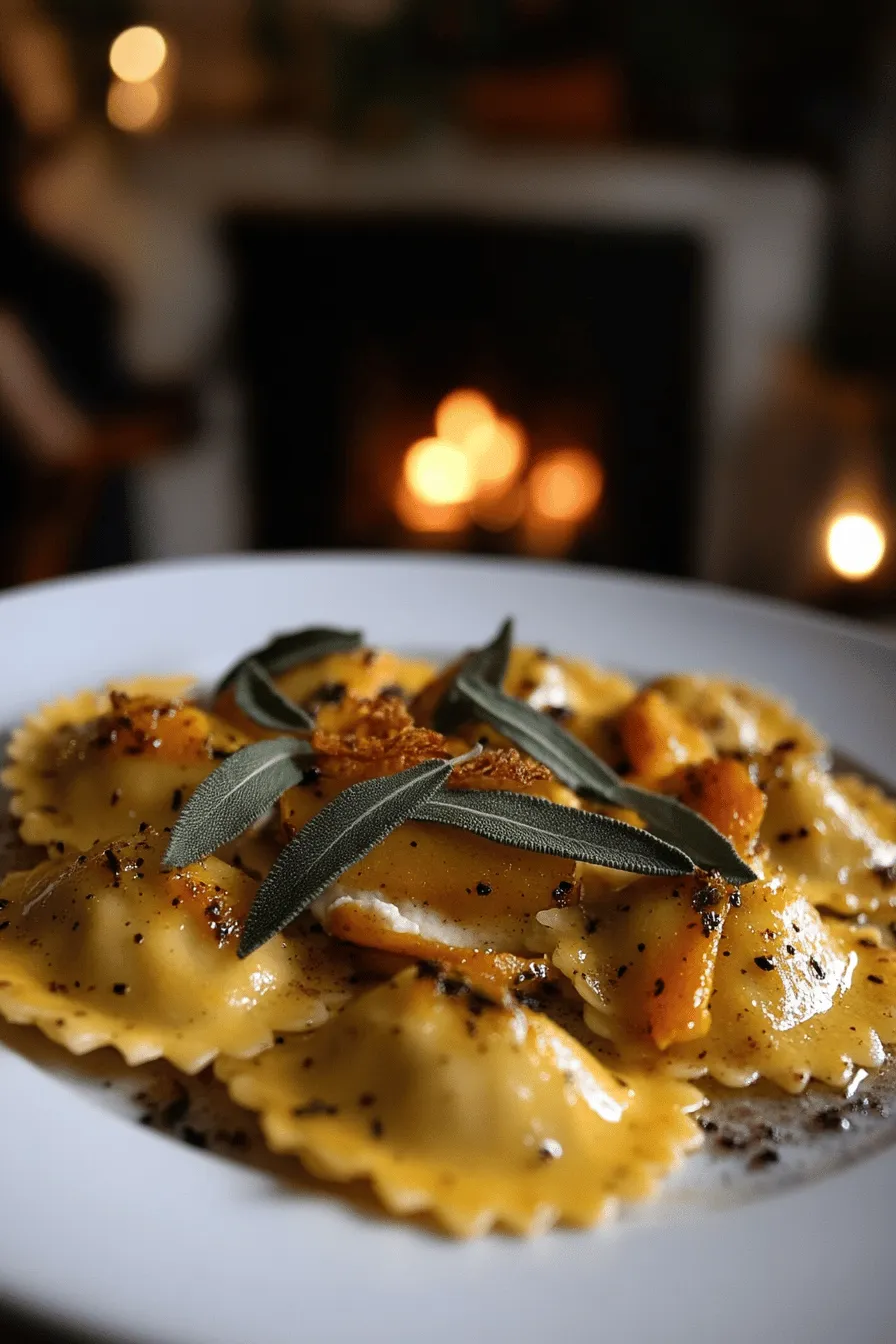If you love pasta and fall flavors, my homemade Butternut Squash Ravioli is perfect for you. This delightful dish combines creamy filling with fresh pasta, making it a hit for any meal. In this article, I’ll guide you through every step, from choosing the best squash to making the perfect sauce. Let’s create a delicious meal that will impress your family and friends! Are you ready to dive in?
What Are the Key Ingredients for Butternut Squash Ravioli?
In making butternut squash ravioli, you need fresh and simple ingredients. The main ingredient is, of course, butternut squash. For the filling, I use two cups of cubed squash. Roasting it brings out the natural sweetness. You also need ricotta cheese, which adds creaminess. A beaten egg helps bind the filling together.
What Ingredients Are Needed for the Perfect Filling?
To create a perfect filling for butternut squash ravioli, combine roasted squash, ricotta cheese, and egg. Add salt, black pepper, nutmeg, and cinnamon for flavor. These spices enhance the sweetness of the squash. You can adjust the seasoning to fit your taste. This filling is rich and smooth, making each bite a delight.
How to Choose the Best Butternut Squash?
When selecting butternut squash, look for firm and heavy ones. The skin should be a rich beige color. Avoid any squash with soft spots or blemishes. A good squash will have a smooth skin and feel solid in your hands. If you choose a fresh squash, you can enjoy its sweet flavor in your dish.
Are There Any Alternatives for Traditional Ingredients?
You can swap ingredients if needed. For the filling, use goat cheese instead of ricotta. If you want a dairy-free option, try silken tofu. You can also replace the spices with your favorites. For example, add a pinch of chili powder for a kick. This flexibility allows you to make the dish your own.
For the full recipe, check out the Autumn Harvest Butternut Squash Ravioli recipe.
How Can You Make Homemade Butternut Squash Ravioli?
To make homemade butternut squash ravioli, you start with the dough. First, mix flour and eggs. Use about 2 cups of flour and 3 large eggs. Knead the dough until it feels smooth. Wrap it in plastic wrap and let it rest for 30 minutes. This helps the dough relax.
Next, roll out the pasta. Use a rolling pin or a pasta machine. Divide the dough into small pieces. Roll each piece thin, about 1/16 inch thick. Cut it into rectangles about 3 inches wide. If you use store-bought pasta sheets, lay them flat on a floured surface.
Now, let’s fill those ravioli. Place a heaping teaspoon of filling in the center of each rectangle. Moisten the edges with a bit of water. Fold the pasta over the filling to form a pocket. Press out any air to avoid bursting. Seal the edges well using your fingers or a fork.
To ensure a perfect seal, press firmly around the edges. This step is key. If the edges do not seal properly, the filling may leak out while cooking. You can also crimp the edges with a fork for a decorative touch.
Once your ravioli is ready, cook them in boiling salted water. They will float when done, usually in about 3-4 minutes. For a complete dish, you can pair them with sage butter. This adds a lovely flavor.
For the full recipe, check out the details above. Enjoy your homemade butternut squash ravioli!

What Cooking Methods Work Best for Butternut Squash Ravioli?
How Do You Boil Ravioli to Achieve the Right Texture?
Boiling is the most common way to cook ravioli. It is simple and effective. Fill a large pot with water and add salt. Bring the water to a rolling boil. Drop the ravioli gently into the pot. Cook them for about 3 to 4 minutes. They are ready when they float to the top. This method keeps the pasta soft and tender. I love how the filling stays warm and delicious.
Can You Bake Butternut Squash Ravioli Instead?
You can bake butternut squash ravioli for a different taste. First, preheat your oven to 375°F (190°C). Place the ravioli in a baking dish. Pour a bit of sauce over them. Cover the dish with foil. Bake for about 20 minutes. Remove the foil and bake for another 10 minutes. This method gives the ravioli a nice, crispy edge. It also helps the flavors blend nicely.
What Are the Benefits of Different Cooking Techniques?
Each cooking method has its perks. Boiling keeps the ravioli light and fluffy. Baking adds a nice texture and warmth. You can also steam ravioli for a healthy option. Steaming keeps the flavor but uses less oil. Using different methods can change the dish’s flavor and feel. It allows you to explore and find what you like best.
Which Sauces Complement Butternut Squash Ravioli?
Butternut squash ravioli shines with the right sauces. Creamy sauces for ravioli enhance its sweet and nutty flavor. A rich sauce can make your dish feel special and warm.
What Are Easy Creamy Sauces to Make at Home?
You can whip up a simple creamy sauce quickly. Start with heavy cream or half-and-half. Heat it in a pan over low heat. Add salt, pepper, and Parmesan cheese to taste. Stir until the cheese melts. This sauce coats the ravioli well and adds a nice creaminess.
How to Prepare a Traditional Sage Butter Sauce?
A sage butter sauce is classic for butternut squash ravioli. To make it, melt unsalted butter in a skillet over medium heat. Add fresh sage leaves and cook them. Let the butter turn a light brown color. This brings out a nutty flavor. Pour the sauce over your ravioli and enjoy the herbal aroma.
What Other Sauce Variations Can Enhance the Dish?
You can try many sauce variations. Consider a brown butter sauce. It adds depth and richness. To make it, follow the steps for the sage butter sauce but skip the sage. You can also add a splash of lemon juice for brightness. Another option is to make a creamy mushroom sauce. Sauté mushrooms in butter, then add cream and seasonings. Each sauce brings a new twist to your dish.
For the full recipe on making butternut squash ravioli, check out the details above.

What Are Delicious Serving Suggestions for Butternut Squash Ravioli?
How Can You Serve Ravioli for a Festive Occasion?
Serving butternut squash ravioli at a festive event brings warmth and joy. For holidays, I love to drizzle a rich sage butter sauce on top. It adds flavor and looks beautiful. You can also sprinkle chopped nuts, like walnuts or pecans, for a delightful crunch. Pairing the dish with roasted vegetables adds color and taste. Guests will appreciate the effort you put into this special meal.
What are Great Garnishes to Elevate Your Dish?
To elevate your butternut squash ravioli, consider garnishing with fresh herbs. I often use crispy sage leaves or chopped parsley. These add a fresh aroma and pop of color. You can also sprinkle grated Parmesan cheese on top for a savory touch. A pinch of nutmeg or cinnamon enhances the fall flavors. A drizzle of balsamic reduction makes the dish even more stunning. Simple garnishes can make your meal feel gourmet.
How Do You Pair Wine with Butternut Squash Ravioli?
Pairing wine with butternut squash ravioli is easy and fun. I recommend a light white wine, like Pinot Grigio. This wine’s crispness balances the creamy filling. If you prefer red, a light-bodied wine, such as Pinot Noir, works well too. The fruity notes complement the sweetness of the squash. Serve your wine chilled for the best experience. Wine adds an elegant touch to your dining experience.
How Can You Customize Your Butternut Squash Ravioli Recipe?
What Are Some Unique Filling Ideas to Try?
You can make your butternut squash ravioli even more special. Try adding different cheeses. Goat cheese or blue cheese can give a tangy twist. You can mix in herbs like thyme or rosemary for more flavor. If you like a bit of spice, add some chili flakes. Another idea is to blend in sautéed mushrooms for earthiness. You can also experiment with nuts, like walnuts or pine nuts, for crunch. These fun filling ideas will make your ravioli unique and tasty.
How Can You Make This Recipe Gluten-Free?
If you need a gluten-free option, swap regular pasta with gluten-free pasta sheets. You can find these in many stores now. For a homemade version, use gluten-free flour to make your dough. Mix rice flour, potato starch, and xanthan gum for a great texture. Roll it out just like regular pasta. This way, you can enjoy your butternut squash ravioli without gluten.
What Flavor Pairings Work Well with Butternut Squash?
Butternut squash has a sweet, nutty taste. It pairs well with savory flavors. Try adding sage, which brings out the squash’s flavor. Brown butter also works great with it. You can add a hint of cinnamon or nutmeg for warmth. If you want a fresh touch, consider lemon zest or parsley. These flavor pairings will brighten your dish and make it even more delicious.
In this blog post, we explored how to create delicious butternut squash ravioli. You learned about key ingredients for the filling, including alternatives. We discussed making homemade ravioli, from dough preparation to sealing techniques. You discovered cooking methods and found sauces that complement this dish perfectly. Lastly, we shared serving suggestions and customization ideas.
Butternut squash ravioli is a dish that you can make your own. Enjoy experimenting and savoring every bite!







